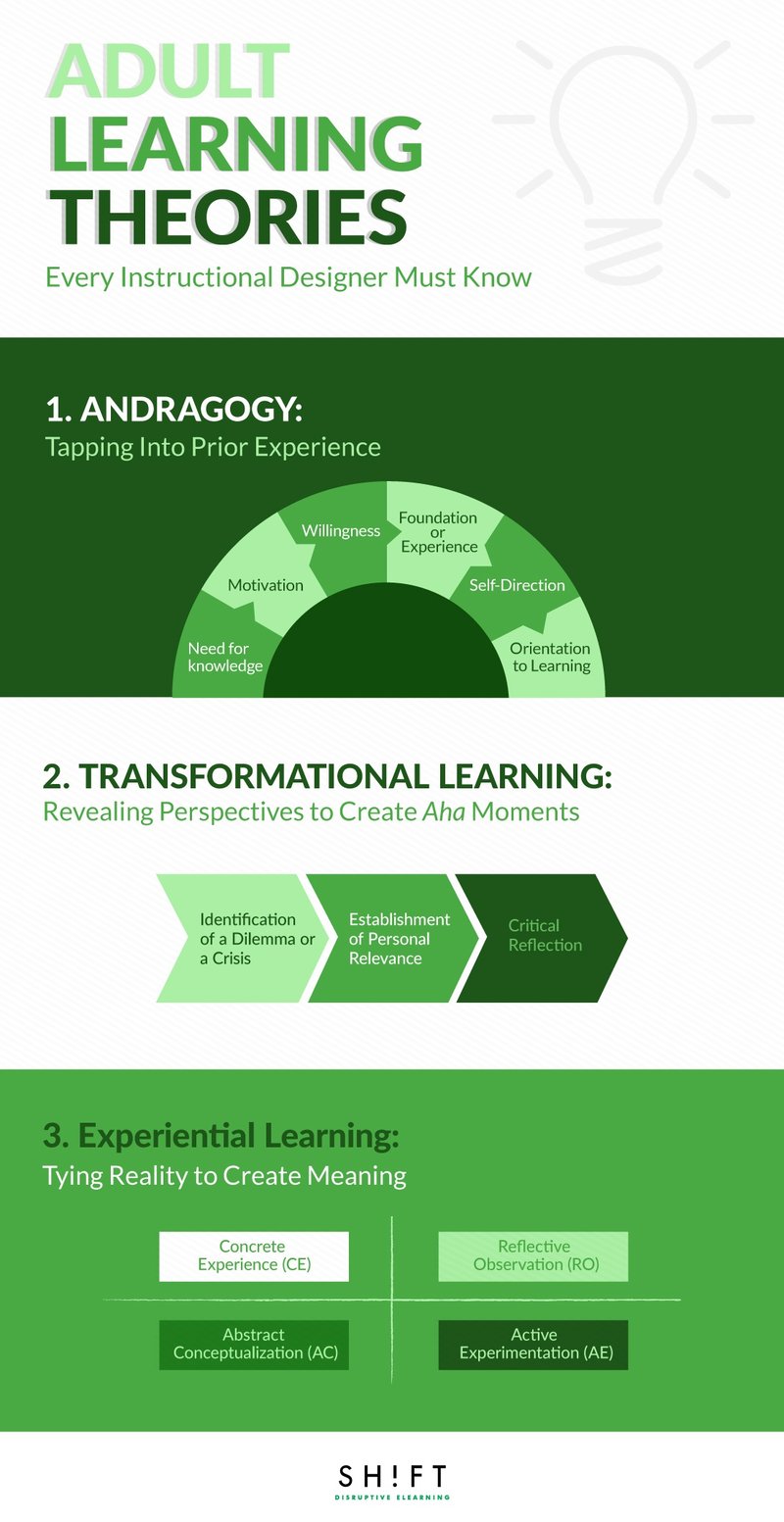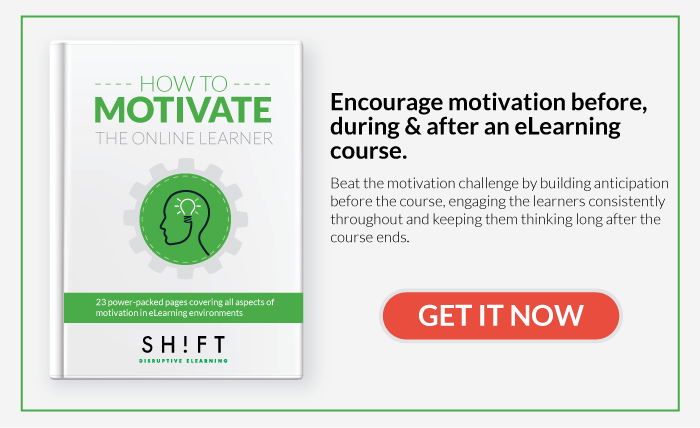As an instructional designer, you want to create courses that make a difference in your audience’s lives. You want to create experiences that inspire them, change mindsets and drive performance. In short, you want to create courses that resonate with them and hit the mark, every time.
Now here’s the challenge. Your learners are adults with previous knowledge and fixed ideas about what works for them. They are busy and stressed-out folks who hate wasting time. They want learning experiences that help them meet their needs and achieve their goals.
This said you MUST understand how adults learn best. When creating your next eLearning course, it is essential to base the design on a good understanding of adult learning theory.
What is Adult Learning Theory?
The phrase “adult learning theory” is much bandied about in corporate training circles. But, do you know what it actually means?
First, a myth-buster. There is NO one adult learning theory. There are several prevalent theories that all explain— from different perspectives—how adults learn.
In this article specifically, we will address: 1) andragogy, 2) experiential learning, and 3) transformational learning. There are many other theories though! However, all of them have one main goal: they help you create effective learning experiences for the adult corporate learner.
Recommended reads:
- Here's Your Quick Guide to Understanding Adult Online Learners
- 4 Elements to Effective Adult Learning, According to Neuroscience
Why Understand Adult Learning Theories?
Adult learning theories are not just a collection of jargon, concepts, and ideas about how adults learn. These theories help you plan your course during conception, development, and execution, in a way that will facilitate the learning process.
Here’re four reasons why instructional designers MUST get acquainted with these theories:
- To create relevance by mapping courses with perceived learner needs
- To devise instructional strategies in alignment with real learning contexts
- To choose the technology that best supports the instructional strategy
- To plan instructional strategies relevant to digital-age and on-the-go learners
Theory #1: Andragogy - Tapping Into Prior Experience
This theory taps into the main characteristics of adult learners and how they bring in their experiences to guide them along the journey of learning. This theory was developed by Malcolm Shepherd Knowles in the 1970s, and it's still relevant today.
According to Knowles, adult learners differ from children in the following six ways:
- Need for Knowledge: Adults need to know “why” they should learn.
- Motivation: Adults are driven by internal motives. They will learn if they want to learn. For instance, a compelling answer to the “what’s-in-it-for-me” question is a powerful internal motivation.
- Willingness: For adults, the willingness or readiness to learn comes from perceiving the relevance of the knowledge. They want to know how learning will help them better their lives, and they learn best when they know that the knowledge has immediate value for them.
- Foundation or Experience: Adults bring with them rich reserves of experiences that form the foundation of their learning. They analyze, rationalize, synthesize, and develop new ideas or tweak old ones through the filter of their experiences. As an instructional designer, you should tap into their well of experiences to help them make connections, perceived relevance, and derive inspiration.
- Self-Direction: Adults are self-directed individuals who want to take charge of the learning journey. They are independent beings who want to feel in control.
- Orientation to Learning: Adults learn best when they “do.” They find relevance in task-oriented learning, which they can align with their workplace realities. Besides, task-oriented learning exercises their problem-solving ability which in turn, gives them the confidence that they can conquer their challenges with their newly-acquired knowledge.
Theory #2: Transformational Learning: Revealing Perspectives to Create Aha Moments
We have all experienced aha moments.
Flashes of inspiration have led us to see reality in new ways. Nuggets of wisdom that have radically changed our mindsets. Deep insights that have busted through long-held beliefs and conventions.
These are transformative experiences that shift our consciousness. As an instructional designer, you should strive to create such learning experiences. Such experiences rouse the mind, stir powerful emotions, and leave lasting impressions. Many such events trigger radical changes in thoughts, perspectives, attitudes, and behavioral patterns—the “transformations.”
Transformational learning theory explains how adults learn through such aha moments. The theory is rooted in the belief that learning occurs when a new meaning is imparted to an earlier experience (Mezirow, 1990) or an old meaning is reinterpreted and seen in a new light.
In the Transformational Learning Theory there are three stages of learning:
- Identification of a Dilemma or a Crisis: The realization that we had all along been holding on to wrong beliefs or that we don’t know what we should know is often a trigger to dig in and unearth information or review our mindsets and thought patterns. Not knowing or realizing that we have the wrong information is a crisis that is deeply upsetting to all of us. You have to point out to your learners what they don’t know to make them curious about your course.
- Establishment of Personal Relevance: This is the context or the answer to the eternal “what’s-in-it-for-me” question that inspires people and drives learning. The context can be personal, professional, or social, and you should establish it right at the beginning of the course to spike interest and reiterate it often to keep learners hooked. Adult learners are motivated to learn when they can envision the results of their efforts.
- Critical Thinking: Your learners are sensible, rational people with minds of their own. So you should create opportunities for critical reflection (premise reflection) to encourage them to re-examine their beliefs and attitudes. When you let them sort through their feelings and thoughts and realize on their own what they need to shed or tweak, they will be more willing to accept and imbibe the learning.
This post outlines ways in which you can create opportunities for transformative learning in an online learning environment.
Theory #3: Experiential Learning - Tying Reality to Create Meaning
Chinese philosopher Confucius said, “Tell me, and I will forget. Show me, and I may remember. Involve me, and I will understand."
As human beings, we are shaped by our experiences. For adults, no amount of textbook learning can take the place of knowledge, clarity, and wisdom that come from experience.
The Experiential Learning Theory states that the essence of adult learning is making sense of experiences. Adults learn best when they learn by doing. They learn best when they are directly involved with—“experiencing”—the learning instead of memorizing numbers and definitions from books.
Kolb reveals the cyclical nature of experiential learning by explaining how it takes place in four stages:
- Concrete Experience (CE): Adults learn best when the learning experience goes beyond the chalk-and-talk routine. Kinesthetic learning or learning by encouraging physical actions (simulations) and learning that evokes strong emotional responses (realistic scenarios that reveal cause-effect relationships) create powerful experiences that are not forgotten easily.
- Reflective Observation (RO): Adults need to engage with and reflect on their experiences to glean insights and acquire knowledge. So it is critical to not only create opportunities for experience-based learning but also provide time and space to encourage reflection. Create opportunities for “watching” the action unfold before the eyes (demonstrations) and “analyzing” processes and procedures (scenario-driven activities, case studies).
- Abstract Conceptualization (AC): The success of experiential learning lies in the learner being able to decode abstract concepts from their reflections, generalize these ideas, and realize the relevance to their reality. Designs assessments to encourage learners to exercise their “critical thinking” abilities, so they can formulate concepts and procedures.
- Active Experimentation (AE): Role-playing activities, internships, and other hands-on tasks let learners apply the learning and thus truly “learn by doing.” Active experimentation leads to concrete experiences, and the cycle of experiential learning resumes.
Additional reads:
Create Life-Long Learners with Experiential eLearning
Learner Experience Mapping: Building Personalized “Learner-centric” Experiences

Adult learning theories help you step into the shoes of your learners and understand how their minds work. Your message has the greatest chance of hitting its mark if it is framed and presented in a language that your learners understand best.



